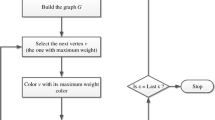Abstract
Cognitive Radio Networks (CRNs) are considered as a promising solution to the spectrum shortage problem in wireless communication. In this paper, we initiate the first systematic study on the algorithmic complexity of the connectivity problem in CRNs through spectrum assignments. We model the network of secondary users (SUs) as a potential graph, where two nodes having an edge between them are connected as long as they choose a common available channel. In the general case, where the potential graph is arbitrary and the SUs may have different number of antennae, we prove that it is NP-complete to determine whether the network is connectable even if there are only two channels. For the special case where the number of channels is constant and all the SUs have the same number of antennae, which is more than one but less than the number of channels, the problem is also NP-complete. For the special cases in which the potential graph is complete, a tree, or a graph with bounded treewidth, we prove the problem is NP-complete and fixed-parameter tractable when parameterized by the number of channels. Exact algorithms are also derived to determine the connectability of a given cognitive radio network.

Similar content being viewed by others
Notes
We assume two heterogenous SUs cannot communicate even when they work on a common channel and their distance is within their transmission ranges.
This can be seen as a generalization of the connectivity concept in graphs. There are also many other types of generalizations, such as the generalized connectivity studied in Li and Li (2012).
Commonly, the white spaces include spectrums from channel 21 (512 Mhz) to 51 (698 Mhz) excluding channel 37, which is totally 29 channels Bahl et al. (2009).
References
Bahl P, Chandra R, Moscibroda T, Murty R, Welsh M (2009) White space networking with Wi-Fi like connectivity. In ACM SIGCOMM
Bodlaender HL (1996) A linear-time algorithm for finding tree-decompositions of small treewidth. SIAM J Comput 25(6):1305–1317
Cayley A (1889) A theorem on trees. Q J Pure Appl Math 23:376–378
Chen X, Huang J (2012) Spatial spectrum access game: nash equilibria and distributed learning. In ACM MobiHoc
Dolev S, Gilbert S, Guerraoui R, Newport CC (2007) Gossiping in a multi-channel radio network. In DISC
Downey R, Fellows M (1998) Parameterized complexity. Springer, Berlin
Du H, Wu W, Shan S, Kim D, Lee W (2012) Constructing weakly connected dominating set for secure clustering in distributed sensor network. J Comb Optim 23(2):301–307
Fürer M, Raghavachari B (1994) Approximating the minimum-degree steiner tree to within one of optimal. J Algorithms 17(3):409–423
Gabow H, Myers E (1978) Finding all spanning trees of directed and undirected graphs. SIAM J Comput 7(3):280–287
Garey M, Johnson D (1979) Computers and intractability: a guide to the theory of NP-completeness. W. H. Freeman, New York
Hopcroft J, Karp R (1973) An \(n^{5/2}\) algorithm for maximum matchings in bipartite graphs. SIAM J Comput 2(4):225–231
Kloks T (1994) Treewidth: computations and approximations, vol 842 of LNCS. Springer, Berlin
Kuhn F, Wattenhofer R, Zollinger A (2008) Ad hoc networks beyond unit disk graphs. Wirel Netw 14(5):715–729
Li S, Li X (2012) Note on the hardness of generalized connectivity. J Comb Optim 24(3):389–396
Li X.-Y., Yang P, Yan Y, You L, Tang S, Huang Q (2012) Almost optimal accessing of nonstochastic channels in cognitive radio networks. In IEEE INFOCOM
Liang H, Lou T, Tan H, Wang Y, Yu D (2013) Complexity of connectivity in cognitive radio networks through spectrum assignment. In ALGOSENSORS’12, vol 7718 of LNCS, pp 108–119
Lu D, Huang X, Li P, Fan J (2012) Connectivity of large-scale cognitive radio ad hoc networks. In IEEE INFOCOM
Ren W, Zhao Q, Swami A (2009) Connectivity of cognitive radio networks: Proximity vs. opportunity. In ACM CoRoNet
Ren W, Zhao Q, Swami A (2009) Power control in cognitive radio networks: how to cross a multi-lane highway. IEEE JSAC 27(7):1283–1296
Robertson N, Seymour PD (1986) Graph minors. ii. algorithmic aspects of treewidth. J Algorithms 7:309–322
Shukla A (2009) A short proof of Cayley’s tree formula. arXiv:0908.2324v2. IEEE JSAC 27(7):1283–1296
Wang B, Liu KJR (2011) Advances in cognitive radio networks: a survey. IEEE J Sel Top Signal Process 5(1):5–23
Yu J, Roh H, Lee W, Pack S, Du D-Z (2012) Topology control in cooperative wireless ad-hoc networks. IEEE JSAC 30(9):1771–1779
Yuan Y, Bahl P, Chandra R, Moscibroda T, Wu Y (2007) Allocating dynamic time-spectrum blocks in cognitive radio networks. In ACM Mobihoc
Zhou X, Gandhi S, Suri S, Zheng H (2008) ebay in the sky: strategyproof wireless spectrum auctions. In ACM MobiCom
Acknowledgments
The authors would like to give thanks to Dr. Thomas Moscibroda at Microsoft Research Asia for his introduction of the original problem. This work was supported in part by the National Basic Research Program of China Grant 2011CBA00300, 2011CBA00302, the National Natural Science Foundation of China Grant 61073174, 61103186, 61202360, 61033001, and 61061130540.
Author information
Authors and Affiliations
Corresponding author
Additional information
A preliminary version of this paper appeared in ALGOSENSORS 2012 Liang et al. (2013). The main extensions are that we give more details of our results and investigate the special case where the potential graphs are of bounded treewidth.
Rights and permissions
About this article
Cite this article
Liang, H., Lou, T., Tan, H. et al. On the complexity of connectivity in cognitive radio networks through spectrum assignment. J Comb Optim 29, 472–487 (2015). https://doi.org/10.1007/s10878-013-9605-0
Published:
Issue Date:
DOI: https://doi.org/10.1007/s10878-013-9605-0




